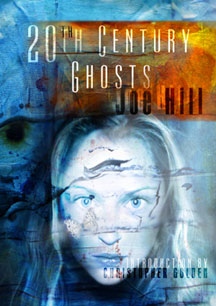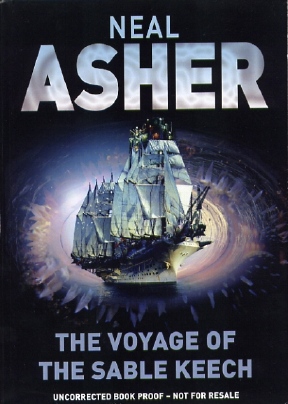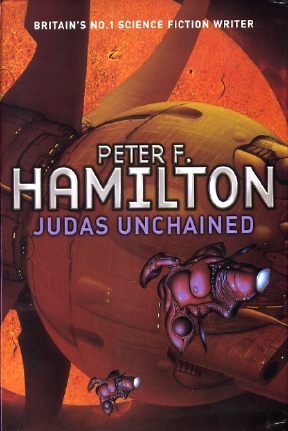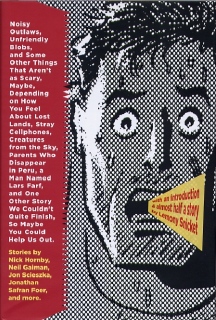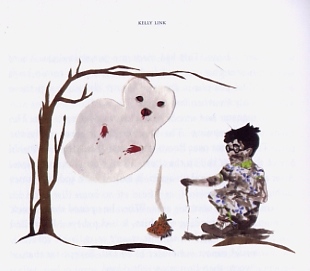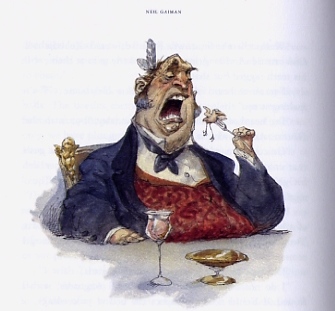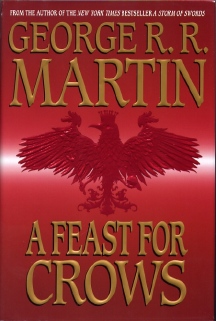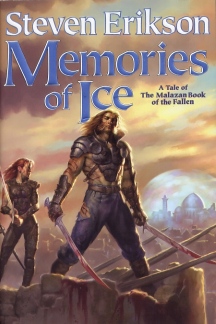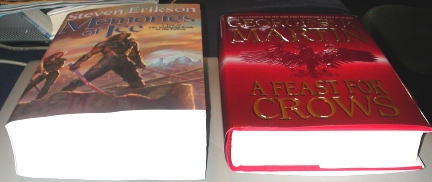|
|
|
This Just In...News from the Agony Column
|
11-18-05: Joe Hill is Haunted by '20th Century Ghosts' |
||||||
| Modern
Horror And the Ugly Mind by Terry Weyna
The most intriguing of the titles new in October 2005, however, is Joe Hill's '20th Century Ghosts'. It's available in three different versions: the deluxe slipcased hardcover (200 copies, with additional material and author's story notes, £60/$90); the hardcover (500 copies, £25/$45); and the unsigned trade paperback (1,000 copies, £15/$25). The deluxe hardcover and the hardcover both have a brilliant orange cover by Vincent Chong, one in which symbols and signs from all the stories are recognizable. The trade paperback has a cool blue cover, also by Chong, in which the ghost from the title story appears so white, so blue, so washed-out and yet still so alive, that you can get creeped out just staring into her eyes. This cover depicts only the title story, but the evocative word "Rosebud" on the rear cover, floating in neon above a seemingly abandoned – or perhaps haunted? – theater pulls the reader inside the pages with alacrity.
However, I would enthusiastically recommend reading them. Such great writing graces the horror field with less frequency than we like. The reworkings of old tropes, and the brand new ideas springing from these stories, make this collection one that may well become a classic in the field. Don't miss out. |
|
11-17-05: Neal Asher Embarks on 'The Voyage of the Sable Keech' |
|||
| All
Monsters, All the Time We love our monsters, whether they run for office, are in office or are on their way out of office. Oh, and we love the kind that have tentacles and drip slime as well. No matter where in their journey to and from elected officialdom we may happen to find them. And the kind we love best are the kind that reside solely in our own imagination. What can more perfectly create for us our nightmares, our fears? Nothing, it's clear. Nobody will ever, ever put together special effects that match those in our minds. And few writers can match Neal Asher when it comes to scripting the stories that create those monsters for us. While I've enjoyed every one of Neal's novels, my favorite has to be 'The Skinner'. Set on the planet of Spatterjay, 'The Skinner' was a wonderfully complex novel that read like a deliriously simple monster movie. But for all the mayhem, all the horror, the non-stop cavalcade of violence, blood and ichor, there was a sort of wistfulness about the book. Yes, you're floating on a sea filled with quite-well described monsters, but it's OK, the wind is blowing the sail is in a good mood -- Say what? Yes, the sail, the living sail is in a good mood. On Spatterjay, just about everything is living, unless it's being eaten or digested. And even then, you're often likely to remain alive. To suffer more. Or be re-elected.
'The Voyage of the Sable Keech' finds all the characters we know and love out on the high seas of Spatterjay once again, and though Keech himself has been successfully resurrected, there are questions lingering as to exactly why this "re-ification" took so well. Did it have something to do with the Spatterjay virus? Or was there another reason, tied to those alien war criminals? I, for one cannot wait to find out and to this end, I've cruised through more of the book than I'd care to admit before even officially starting it. I can confirm that once again, the chapters are headed by descriptions of the flora and fauna of Spatterjay. And I can confirm that Keech and Captain Ron are on hand. Captain Ron! It's almost too delightful to contemplate. What's interesting are the plans that Macmillan / Tor UK has for this book. First off, you'll note that theyve changed the cover design. I love the illustration, but I prefer the old cover design. It's probably just that I'm so conservative. I like things just the way they were. But given the new cover design, I'm rather anxious to see a full-blown version of 'Brass Man', which they show in a little piccie on the back cover. I think I could come to like this design just as well as the former all-weirdness-chaos style. But they've simplified for a reason. Buoyed by the success of 'The Skinner', Tor UK is daring to suggest that this (well, 2006, I guess) is the year that Asher "explodes out of the genre and into the mainstream." Say what? You're seriously telling me that this "all monsters, all the time" novel is going to be a mainstream success? Not that it doesn't deserve it, mind you. But even if it lives up to the gold standard set by 'The Skinner', it does behoove one to remember how totally, utterly outré that novel was. For me, these are precisely the types of novels that should be mainstream bestsellers, but then, I'm noted for championing the very strange. How Ma and Pa Kettle (as opposed to Ma and Pa Kleffel) will receive 'The Voyage of the Sable Keech' is well, certainly a series of events worthy of close study. I'll be the first to jump up and down and cheer if Asher gets the success that he so richly deserves. And frankly, 'Brass Man' is a pretty damn great backup novel, with to my mind more crossover potential than 'The Skinner' had. Of course, this is sort of like saying that 'Freaks' has more mainstream appeal than 'Eraserhead'. There's appeal to the mainstream, to be sure, but are the same folks who buy all those Jamie Oliver books going to buy Asher's novel? Well, I guess they're both about eating -- or in Asher's case, being eaten. And there's lots of slow roasting going on in both! So, yes, maybe Neal Asher is ready to break into the mainstream. And 'The Voyage of the Sable Keech'? It's a cookbook. |
|
11-16-05: Peter F. Hamilton Finds 'Judas Unchained' |
|||
One
Book in Two
The first half of the story came out last year in 'Pandora's Star', also billed as 'Part One of the Commonwealth Saga'. And that sub-head was the only clue you needed. Now on one hand, we're not inclined to be thrilled when publishers pop out Eric the half-a-novel. But when the novel is over 1,800 pages, well, it is quite understandable. The question you've got to be asking yourself is, "What kind of novel needs to be over 1,800 pages?" And answer is simple: A Peter F. Hamilton space opera. Hamilton is fully in his best writing space here, creating a huge and complex universe. Now clearly, this is perhaps not the book for every reader in this universe. But for the ever-increasing audience that loves to get lost in a complex saga that refracts our world through the lens of science fiction inventions and adventure, this is no less than the bee's knees. This is literature as dinner, dessert, and an after-dessert aperitif. This is full-on, satisfaction-guaranteed immersive reading. Of course, there might be some who think such a meal a bit on the rich side, and a bit on the obscure side. But need I remind those readers of the -- is it billions? -- of dollars spent on the comparatively shallow and unsatisfying *.* movie franchise? Here are two books which will accomplish everything that those works promised, and so much more, playing on a screen as wide as your imagination. Moreover, the length is, in retrospect, just about right. At around 900 pages a pop, the two books of that comprise 'The Commonwealth Saga' are long enough to provide the kind of immersion that the genre requires but not so long as to be: a) unwieldy when you're reading them and b) so imposingly long that they never get read. But now that both are out, those who like to wait until the series is complete to begin can dive in and have at it. For those who already have started the series, prepare to be injected directly back into the story, little of which I'll reveal here for fear of spoiling it for those who have not yet started the first book. Suffice it to say that in the year 2380, humanity has colonized six hundred planets and connected the Commonwealth with wormholes. It's pretty decent society in which to live. Human lives have been extended, and everything looks pretty hunky-dory until a distant star vanishes. About then, humanity realizes that things may not be quite what they seem, and that the Fermi paradox is about to be solved in a most unpleasant fashion. As one might surmise from the title, 'Judas Unchained' finds humanity at peril and threatened by a traitor. You'll have to venture 22 pages into 'Judas Unchained' before you'll find out what happened to the characters literally left hanging at the end of 'Pandora's Star'. But again, given the title, you can imagine that opening up Pandora's Star proves to bring with it a few more problems than it does benefits. As befits a Peter F. Hamilton space opera, things go from bad to worse in a big way in 'Judas Unchained'. But for readers who want the assurance that, "That's all there is," let me assure you that this book-brick does wrap up the story. And while I enjoyed Hamilton's stand-alones well enough, I happen to love the big-scale stuff best. I remember getting lost in the 'Night's Dawn' trilogy. It offered me the kind of reading pleasure I'd not seen in science fiction for many, many years. Hamilton is one of those writers who can create a universe that the reader can explore not only as the books are read, but afterwards in memory. And now that this series is complete, we can add the Commonwealth Universe to our collective science fiction memories. And while one is tempted to think that these are big books simply because they look big, the fact of the matter is that getting an entire universe in two books -- or one -- is a pretty significant feat of reduction. For readers, it pays to give space some space. |
|
11-15-05: Noisy Outlaws and (lots) More from McSweeney's |
|||||||||
Who
Would Have Thought...?
Moreover, since this is supposedly a book for young adults and a McSweeney's book, it is absolutely gorgeously designed and intensely illustrated. If you have any interest in reading short stories by the aforementioned authors in a beautiful setting, I guarantee that once you pick up this book you wont want to leave your local independent bookseller without it.
Snicket also provides an introduction nearly as entertaining as his alter-ego's review of Barbara Boxer's new novel. After that, all you've got left are the stories...and the illustrations. Given the list of contributors, you can guess that youre in for quality entertainment, boosted in part perhaps because we're talking a PG-13 excursion here. Kelly Link's contribution is the enticingly-titled 'Monster', and I'm happy to report that it delivers a monster. And this is not just the chomp-and-run variety, but a monster that engages in a lively conversation with James Lorbick, a kid "enjoying" a month away at summer camp. Which is precisely the type of monster I personally find most interesting.
So look, you can cough up the dough for any one of a zillion short story collections. But only one will include a dust jacket that doubles as a short story and contest entry. Even if you're not planning on entering the "roll your own Lemony Snicket Story" contest, then at least you've got this boss dust jacket to show for it. |
